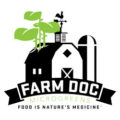Using microgreens as a form of nutritional therapy is not a new concept. These so-called ‘functional foods’ represent a class that carries high content of nutritional bioactive components. Microgreens , a.k.a. sprouts or shoots, certainly fit in this category with their concentrated nutritional properties. Although microgreens have been on the scene for over 30 years, large scale peerreviewed research had not previously been performed. A study done at the University of Maryland by the U.S. Department of Agriculture shed light on the nutritional impact microgreens have as a functional super food.
Comparisons were made utilizing mature leaves and cotyledon stage leaves for nutrient content. Of the available nutrient values, phylloquinone (Vitamin K), carotenoids (lutein and zeanthin), ascorbic acid and tocopherols were assayed. Microgreens were found to contain higher amounts of nutrients than their mature counterparts. Some were exceptionally more such as red cabbage containing 40 times more vitamin E when compared in weight to the mature vegetable. Brassica microgreens such as red
cabbage, purple kohlrabi, red and purple mustard and mizuna are a good source of food polyphenols. Polyphenols are micronutrients accessed through plant-based foods. Their health benefits can help improve conditions like diabetes, neurodegenerative diseases, cardiovascular disease and perhaps help in digestion and weight management.
Antioxidants have also been shown to be concentrated in high contents in microgreens like buckwheat microgreens. Buckwheat microgreens also contain a comparable amount of protein to oats and are gluten-free. Of all the 25 microgreens tested, red cabbage, cilantro, amaranth and green daikon radish had the highest concentrations of vitamin C, carotenoids, vitamin K and vitamin E. Generally speaking, microgreens had five times more vitamins and carotenoids than its mature plant counterparts. The process of how microgreens are grown have not been fully studied and may allow for improvements on their nutritional content. The process of how the seed is sterilized and soaked prior to germination, the length of germination and time until harvest may improve their nutrition content. Fertilization of the growing media, light sources and postharvest practices like washing and storage may also play a role.
